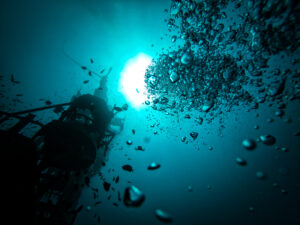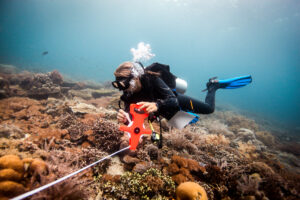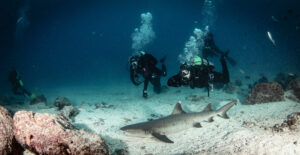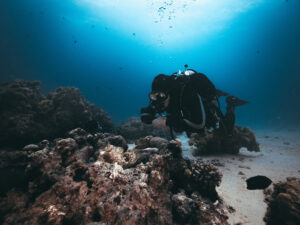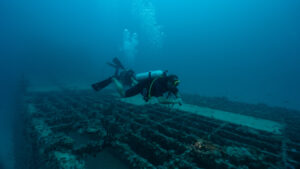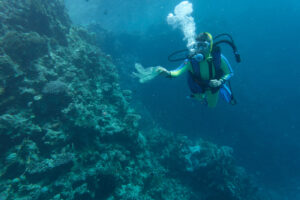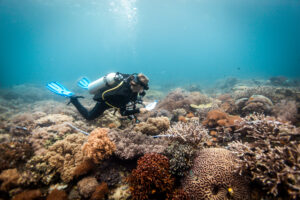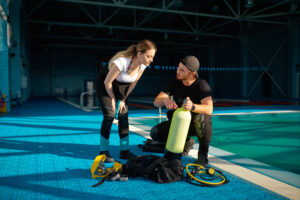What is a Slate in Scuba Diving?
The word “slate” might call to mind the traditional writing surfaces used by schoolchildren of the past, yet in the context of scuba diving, the term refers to a robust tool fundamental to underwater communication. A scuba diving slate is a rigid plastic tablet that divers use to jot down messages or notes during a dive. This tool, simple in design but multifaceted in function, plays a crucial role in enabling communication in an environment where verbal interaction is impossible.
Description and Composition
Scuba diving slates typically consist of a flat, smooth surface made from durable, waterproof plastic. They come in various sizes, from small, wrist-mounted options to larger, free-hanging designs. The most common color is white, which enhances readability underwater. Each slate is usually equipped with a pencil or stylus made of graphite or another non-soluble material, often attached by a cord to prevent loss. Some slates even feature multiple pages, connected via rings, for extended note-taking capacity.
Role in Underwater Communication
Underwater, where speaking is not an option, non-verbal communication reigns supreme. Hand signals are the primary method divers use to convey basic information. However, for more complex messages, instructions, or observations, a slate becomes indispensable. Divers can write notes, draw diagrams, or even sketch marine life encountered during the dive. In technical and scientific diving, slates are often used to record data or procedural steps.
Safety and Navigation
A slate is not just a communication tool but also a device that enhances safety and aids navigation. Divers can use slates to write down pre-dive safety checks, decompression schedules, or dive plans. In instances where visibility might be compromised, divers can sketch maps or mark important locations on their slates. They can also record air consumption rates at various depths, assisting in the calculation of the remaining bottom time and ensuring a safe ascent rate.
Educational and Ecological Use
In an instructional setting, diving slates prove invaluable. Dive instructors can write down skill demonstrations or key points to remember, helping student divers understand and perform tasks more effectively. Furthermore, slates are used extensively in marine ecology, where divers document species sightings and behavior, or in underwater archaeology, where they record findings.
Maintenance and Care
Like all diving equipment, a scuba slate requires proper care and maintenance. After each dive, the slate should be rinsed with fresh water to remove any salt, sand, or other particles. If the writing surface becomes less effective over time, a simple scrub with a mild abrasive like toothpaste can rejuvenate it. The attached pencil or stylus should also be checked regularly for wear and replaced as necessary.
Types of Slates
The scuba slate market is rich in diversity, catering to various needs and preferences. The four primary types are: wrist slates, which are compact and convenient for quick notes; larger, handheld slates for more extensive note-taking; multi-page or flip slates, designed to store a large amount of information; and glow-in-the-dark or illuminated slates, beneficial for night dives or deep dives with low light conditions.
Customization
Some divers customize their slates for specific purposes. For instance, photographers might have a slate with a checklist of shots they want to capture, while marine biologists might have illustrations of various species for identification purposes. Similarly, dive leaders or instructors may have pre-printed templates on their slates, including safety checklists, dive plans, or instructional steps.
Digital Slates
As technology advances, the traditional slate is undergoing a digital transformation. Some manufacturers now offer electronic slates or “e-slates.” These devices, while maintaining the basic functionality of a traditional slate, offer additional features such as the ability to save notes, integration with dive computers, and even the option to upload dive information to a computer or cloud service.
The Slate in Dive Culture
In scuba diving culture, the slate has also taken on a symbolic meaning. It’s often used to refer to a new diver’s lack of experience, with the phrase “clean slate” indicating that a diver is starting from scratch, ready to learn and gain experience.
Environmental Considerations
Scuba divers, as ambassadors of the underwater world, carry a responsibility to minimize their impact on marine environments. Choosing a durable slate made from eco-friendly materials and ensuring it is securely attached can help prevent accidental loss, reducing potential harm to marine life.
Future of the Slate
With advancements in technology and a growing focus on environmental sustainability, the future of the slate in scuba diving is set to evolve. However, the essence of the slate—the ability to communicate in an environment that renders humans mute—will continue to remain indispensable. As long as humans explore the underwater realm, the slate, in one form or another, will continue to be a diver’s silent companion.
Key Takeaways
In conclusion, the slate, a simple, flat piece of plastic, is so much more than it appears. It’s a lifeline, a teacher, a guide, and a canvas. It encapsulates the spirit of scuba diving: the thrill of exploration, the importance of communication, and the joy of sharing our experiences with others. Whether you’re a seasoned diver or new to the sport, the slate is a tool that encapsulates the very essence of our underwater endeavors.


